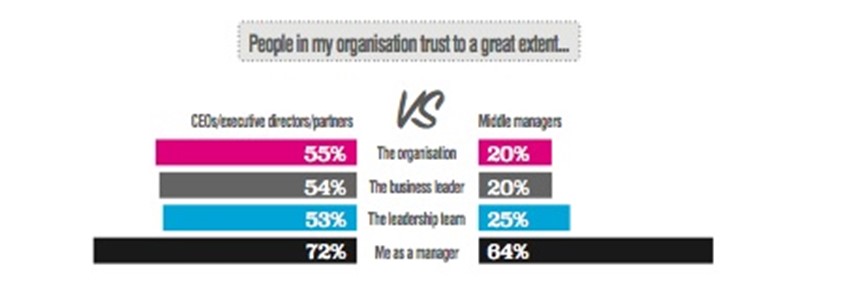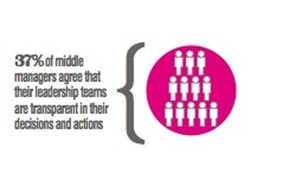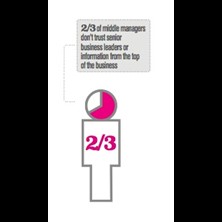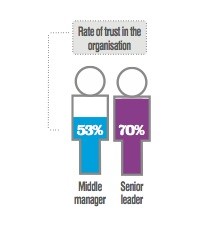
GAINING THE MIDDLE GROUND
Trust is the currency businesses thrive on. But a lack of trust exists between corporate leaders, middle managers and the rest of employees. How can communications help bridge the gap? Hassan Butt reports
From slogan-worthy Gordon Gekko quotes to the fabled top-floor tap on the shoulder, the evolution of the corporate landscape has come a long way since the days of boiler-room operations and bulky business suits. As boardrooms diversify and innovations creep through the cracks of bureaucracy, the role of trust and communication in the workplace require a need for integration at the management level now, more than ever. For CEOs and middle managers, the illusory gaps between what is and isn’t said can often act as indices to a healthy business relationship, and whether there are lingering emails in inboxes or open door policies, the fact remains, transparency is key.
A report entitled ‘The Middle Manager Lifeline’ presents detailed information regarding trust and communication in organisations. It comes as a result of a partnership between internal communications and events consultancy, Top Banana, and the Chartered Management Institute (CMI). The report focuses on the role of trust within organisations, and how middle management is crucial in building a trusting environment. The research animates the importance of communicative and dynamic interactions between senior leaders and their employees.
A total of 1,456 managers took part in the survey, with 44% (642) of the participants holding middle management or consultancy positions. A further 29% (427) held senior management positions.
The survey points out a number of statistical talking points in the discussion of workplace harmony. Yet, not only is the report focused on the presence of trust in organisations, it describes the remit of trust in the breakdown of the decisions, motives, objectives and cultures that form organisations. The report highlights that both 85% of middle managers and 88% of senior managers agreed that trust and communication are paramount to organisational performance and are a major component of growth. And, 37% of middle managers agree that their leadership team is transparent in their decisions and actions, with 41% of middle managers describing management style as bureaucratic and 35% describing it as authoritarian.

With trust forming a major element of organisational structure, the consequences of when trust doesn’t work may be the straws that eventually break the camel’s back. As the survey outlines, only 31% of its respondents feel confident in communicating company information to ensure objectives cascade. Aligning the wider goals of a business at each level of management is therefore crucial in leveraging high performance. A middle manager in the engineering sector says that trusting middle management for its technical assets is equally important in delivering business strategy, “A lot of that middle group are people who have developed through the organisation. They have become experts in various technical parts of the organisation. If that knowledge isn’t recognised, then you can hollow out an organisation and lose all the critical knowledge that’s made the organisation the success that it is.”
American technology company Kodak is an example of when seemingly durable foundational structures becoming a tumbling Tower of Babel. Kodak's positioning in the burgeoning digital market told a story of longevity, transgressing the metamorphosis from analogue to digital, Kodak seemed well-equipped and ready to take on the highly competitive developments of the digital photography industry. But even with loyal employees suggesting Kodak take its numerous assets to the heart of the digital landscape, Kodak's slow downsizing matched with misinformed direction led to a disintegration of its once-formiddable digital imprint.
Similarly, with the dotcom bubble proving to be a thorn in the side of product-focused organisations, businesses such as British entertainment retailer HMV had well-documented lapses in knowledge about consumer trends. With miscommunications at senior levels and middle managers left without a paddle, HMV's substantial loss to giants such as Amazon and Apple, although perhaps inevitable, may have been prologned with accurate and effective communications, and as MD Steve Knott tried to pre-empt the subsequent industry shift, HMV's downfall may have been felt hardest by its middle managers.
The human consequences in failing to embrace the developments of any market are centred around the belief in an organisation's messag,e as the survey suggests, CEOs, directors and partners trust the organisation, the business leader and the leadership team more than middle managers do, with one in five reporting little trust in those categories. The 2016 Edelman Trust Barometer showed that a growing inequeality of trust can be placed squarely in an organisation's senior decisions. The report suggests that behaviours of trusted and distrusted companies are polarised in their differences, with distrusted companies displaying overall insularity as opposed to a wider, more positive outlook from trusted companies.


Yet, as middle managers see different aspects of the organisation, their belief in the organisation and what their leaders tell them may well be tarnished by heavy responsiblities both upwards and downwards, like the middle child syndrome. The survey showed that although half of middle managers felt they could trust what their organisation could tell them, it was no match for a 70% rate of trust from senior leaders. Lightening the load for middle management is in many ways, according to CEO of the CMI, Anne Francke, a process of reflection, "If you are a senior manager or leader, think back to a time when you had a good boss, think about what they did and do it yourself. Equally think about the bad bosses you've had, and if you think about what they did, I'm sure you'll find that the good bosses were doing more of the top five things their managers wanted."
With 67% of middle managers having low trust in business leaders and 64% believing that a lack of information from the top of the business hinders the development of trust, overall engagement at every level is the lifeblood of working organisations. Multinational technology company, Cisco Systems, provided a model for leadership that sought to engage not only working relations in the organisation, but subsequently its industry output. When its then-CEO, John Chambers, transitioned to executive chairman after a 20-year tenure and allowed current CEO Chuck Robbins to take over, the management changes were implemented to spurn bureaucracy and engage in people relations. Cisco’s results produced positive employee testimonials from the breadth of its internal departments.
Recent Gallup report, 'Analytics and Advice for B2B Leaders,' found that 62% of U.S. workers in B2B industries strongly believe their companies deliver on their promises. The report says, "The account manager is everything to the customer relationships. This individual is responsible for building and maintaining an optimal relationship with the customer and the internal team." Building on this, Gallup found that strong customer relations are fostered in collaboration, as partnerships start at the top, a willingness to take chances and procure long-term, dynamic relationships ‘unknot the bow tie’ of complex executive relationships.
Nick Terry, managing director of Top Banana, says, “I would probably advise a chief executive to ask themselves whether they are looking for someone for status quo – someone who’s going to play the same beat – or are they looking for someone who’s going to embrace change. They might look at this research and say to themselves, ‘I’ve got 30,000 staff, how am I going to get my face to them?’ Well then it’s a case of thinking about clever ways to put them in a room, create interaction, demonstrate listening. You can manage performance in a declining business if you have humility.”
As the report hones in on the need for positive relationships between senior and middle management, the influence of culture forms a missing piece to a much larger puzzle. The rise in offshore business and the global approach to investor relations have resulted in growing relationships that move beyond the boundaries of traiditional workplace interactions. Getting leaderships in front of a workforce requires well-designed platforms for employee interactions like intranets, digital conferenceing and internal social media.
Focusing solely on the UK, the question of whether the survey's results reflect a global issue remains to be seen. Francke adds, "There will be cultural norms, for example there are cultures where hierarchy is till more important, and where more direct communication is less practiced, so you do need to nuance these things and make allowances and acceptances. But fundamentally, culturally appropriate communication is always going to result in better trust than non-communication, and yes you do need to put that in a cultural context, but I think the core principles remain valid."
Moving forward, as both Terry and Francke stress the need for the insights to be implemented and disseminated accurately, they've devised the acronym CIVIC (communications, integrity, visibility, interaction and connections) to provide a format for the future. Although the report highlights the need for two-way communication, its focus on middle management at times blankets the need for top-down change. The report concludes with the onus falling into the clutches of high-trust managers, whose insights come as a result of being trusted, receiving adequate information and having high levels of confidence. That said, Top Banana and the CMI's research continues to prove that gaining the middle ground is an ongoing industry challenge.



